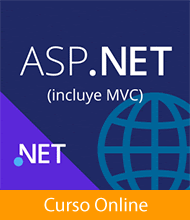lunes, 9 de octubre de 2017
 Ahí van los enlaces recopilados durante la semana pasada. Espero que os resulten interesantes. :-)
Ahí van los enlaces recopilados durante la semana pasada. Espero que os resulten interesantes. :-).NET / .NET Core
- Swashbuckle con ASP.NET Core y AAD B2C
Eduard Tomás - Roslyn Primer – Part I: Anatomy of a Compiler
Anthony D. Green - Dissecting the local functions in C# 7
Sergey Teplyakov - User Interface Unit Tests with .NET Core
Ricardo Peres - C# 7 Series, Part 5: Private Protected
Mark Zhou
Publicado por José M. Aguilar a las 8:55 a. m.
Nadie ha comentado la entrada, ¿quieres ser el primero?
Etiquetas: enlaces
martes, 3 de octubre de 2017
 Al dar el salto a una nueva tecnología como ASP.NET Core, en muchas ocasiones nos encontramos con el problema de no saber cómo hacer cosas que con las tecnologías tradicionales teníamos completamente controladas. Ya hemos comentado por aquí varios casos (como el Application_Start(), los custom errors o las variables de sesión) y hemos visto cómo se mapean estas funciones al nuevo framework, pero hay muchos más.
Al dar el salto a una nueva tecnología como ASP.NET Core, en muchas ocasiones nos encontramos con el problema de no saber cómo hacer cosas que con las tecnologías tradicionales teníamos completamente controladas. Ya hemos comentado por aquí varios casos (como el Application_Start(), los custom errors o las variables de sesión) y hemos visto cómo se mapean estas funciones al nuevo framework, pero hay muchos más.Otro ejemplo muy habitual lo encontramos con
MapPath(), un método perteneciente a la clase HttpServerUtility de ASP.NET "clásico" que utilizábamos para obtener una ruta física a partir de la ruta virtual o relativa de un recurso. Por ejemplo, en el siguiente código mostramos cómo averiguar la ruta en disco de una imagen utilizando este método:var path = HttpContext.Current.Server.MapPath("~/images/image.jpg");
// path = C:\inetpub\wwwroot\mysite\images\image.jpg
Pues bien, ni en ASP.NET Core ni en MVC tenemos disponible la clase System.Web.HttpContext, ni por tanto una propiedad Server de tipo HttpServerUtility que usábamos para invocar al método MapPath(). Sin embargo, disponemos de herramientas alternativas que nos permiten conseguir lo mismo, aunque, eso sí, de forma algo menos directa.
lunes, 2 de octubre de 2017
 Ahí van los enlaces recopilados durante la semana pasada. Espero que os resulten interesantes. :-)
Ahí van los enlaces recopilados durante la semana pasada. Espero que os resulten interesantes. :-).NET / .NET Core
- Plataforma .NET, Plataforma .NET Core y Xamarin: el panorama de las tecnologías de desarrollo Microsoft en 2018
José Manuel Alarcón - .NET Framework 4.7.1 Runtime and Compiler Features
Preeti Krishna - Possessive apostrophes in C# identifiers
Simon Harriyott - The Book of the Runtime - The internals of the .NET Runtime that you won’t find in the documentation
Scott Hanselman - Interesting C# 7.x features - Part 02
Malisa Ncube - Better Performance from Async Operations
Steve Smith - Upcoming features and enhancements in C# 7.2
Kapil Khandelwal - C# Tools to Help with Your Code Quality
Erik Dietrich - Interface Method Implementation C# 8.0
DotNetCrunch - .NET Core CLI and MSBUILD Cheat Sheet
Carlos Mendible
martes, 26 de septiembre de 2017
 En las versiones clásicas de ASP.NET, el archivo Global.asax proporcionaba vías para implementar lógica personalizada cuando la aplicación arrancaba y era detenida, lo que podía resultar bastante útil, por ejemplo, para registrar estos eventos en un log, precargar cachés, inicializar bases de datos, “engancharnos” a servicios externos, etc.
En las versiones clásicas de ASP.NET, el archivo Global.asax proporcionaba vías para implementar lógica personalizada cuando la aplicación arrancaba y era detenida, lo que podía resultar bastante útil, por ejemplo, para registrar estos eventos en un log, precargar cachés, inicializar bases de datos, “engancharnos” a servicios externos, etc.Por ejemplo, en el siguiente código vemos cómo podíamos aprovechar los eventos
Application_Start() y Application_End() para guardar un registro básico de estos sucesos:public class MvcApplication : System.Web.HttpApplication
{
private static string _logFile;
protected void Application_Start()
{
...
_logFile = Server.MapPath("log.txt");
File.AppendAllText(_logFile, DateTime.Now + ": Starting\n");
}
protected void Application_End()
{
File.AppendAllText(_logFile, DateTime.Now + ": Stopping\n");
}
}IApplicationLifetime, proporcionando, entre otras cosas, vías para suscribirnos a eventos relacionados con el ciclo de vida de una aplicación.
lunes, 25 de septiembre de 2017
 Ahí van los enlaces recopilados durante la semana pasada. Espero que os resulten interesantes. :-)
Ahí van los enlaces recopilados durante la semana pasada. Espero que os resulten interesantes. :-).NET/.NET Core
- .NET Core vs .NET Framework: How to Pick a .NET Runtime for an Application
Angela Stringfellow - 3 New C# 8 Features We Are Excited About
Simon Timms - New Free C# 7.1: What's New Quick Start eBook
Jason Roberts - What would a cross-platform .NET UI Framework look like? Exploring Avalonia
Scott Hanselman - .NET Framework 4.7.1 Accessibility and WPF Improvements
Preeti Krishna - Interesting C# 7.x features - 01
Malisa Nnube - C# 7.1’s default value expressions enhancement: default literal expressions
Kapil Khandelwal - Conditional TargetFrameworks for Multi-Targeted .NET SDK Projects on Cross-Platform Builds
Rick Strahl - How to Create a .NET Core CLI Console App as an EXE Instead of a DLL
Jon Gallant - Adding circuit breakers to your .NET applications
Richard Seroter - Deep Dive into OWIN Katana
Kusnaditjung














